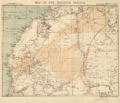The Western Sahara Portal – بوابة الصحراء الغربية
 Western Sahara is a disputed territory in North-western Africa. It has a surface area of 272,000 square kilometres (105,000 sq mi). Approximately 30% of the territory (82,500 km2 (31,900 sq mi)) is controlled by the Sahrawi Arab Democratic Republic (SADR); the remaining 70% is occupied and administered by neighboring Morocco. It is the most sparsely-populated country in Africa and the second most sparsely-populated country in the world, mainly consisting of desert flatlands. The population is estimated at 618,600, of which nearly 40% live in Morocco-controlled Laayoune, the largest city in Western Sahara. Previously occupied by Spain as Spanish Sahara until 1975, Western Sahara has been on the United Nations list of non-self-governing territories since 1963 after a Moroccan demand. In 1965, the United Nations General Assembly adopted a resolution on Western Sahara, asking Spain to decolonize the territory. A year later, a resolution was passed requesting that a referendum be held by Spain on self-determination. In 1975, Spain relinquished administrative control of the territory to a joint administration by Morocco and Mauritania. A war erupted between those countries and a Sahrawi nationalist movement, the Polisario Front, which proclaimed itself the rightful leadership of the SADR with a government-in-exile in Tindouf, Algeria. Mauritania withdrew its claims in 1979, and Morocco secured de facto control of most of the territory, including all major cities and most natural resources. The UN considers the Polisario Front to be the legitimate representative of the Sahrawi people, and maintains the Sahrawis have a right to self-determination. Western Sahara is the last African colonial state yet to achieve independence and has been dubbed "Africa's last colony". Since a UN-sponsored ceasefire agreement in 1991, most of the territory has been administered by the Moroccan government, with tacit support from France and the United States. The remainder is administered by the SADR, backed by Algeria. The only part of the coast in SADR territory is the extreme south. Internationally, countries such as Russia have taken an ambiguous and neutral position on each side's claims and pressed parties to agree on a peaceful resolution. Morocco and Polisario have sought to boost their claims by accumulating formal recognition, especially from African, Asian, and Latin American states in the developing world. The Polisario Front has won formal recognition for the SADR from 46 UN member states and South Ossetia, and was extended membership of the African Union. Morocco has won support from several African governments and most of the Muslim world and Arab League. In most instances, recognitions are extended or withdrawn due to a change in relations with Morocco. Until 2020, no other member state of the UN had ever recognized Moroccan sovereignty over parts of Western Sahara. In 2020, the US recognized Moroccan sovereignty over Western Sahara in exchange for Moroccan normalization of relations with Israel. In 2023, Israel recognized Moroccan sovereignty. (Full article...) The Sahrawi Arab Democratic Republic, also known as the Sahrawi Republic and Western Sahara, is a partially recognized state, recognized by 46 UN member states and South Ossetia, located in the western Maghreb, which claims the non-self-governing territory of Western Sahara, but controls only the easternmost one-fifth of that territory. Between 1884 and 1975, Western Sahara was known as Spanish Sahara, a Spanish colony (later an overseas province). The SADR is one of the two African states in which Spanish is a significant language, the other being Equatorial Guinea. The SADR was proclaimed by the Polisario Front on 27 February 1976, in Bir Lehlou, Western Sahara. The SADR government calls the territories under its control the Liberated Territories or the Free Zone. Morocco controls and administers the rest of the disputed territory, and calls these lands its Southern Provinces. The claimed capital city of the SADR is El Aaiún (the capital of the territory of Western Sahara). Since the SADR does not control El Aaiún, it has established a temporary capital in Tifariti, although most of the day-to-day administration happens in Rabuni, one of the Sahrawi refugee camps located in Tindouf, Algeria. (Full article...) Selected article -
The Settlement Plan (Arabic: خطة التسوية, romanized: Khiṭṭah al-Taswiyah; Spanish: Plan de Arreglo) was an agreement between the ethnically Saharawi Polisario Front and Morocco on the organization of a referendum, which would constitute an expression of self-determination for the people of Western Sahara, leading either to full independence, or integration with the Kingdom of Morocco. It resulted in a cease-fire which remains effective until 2020, and the establishment of the MINURSO peace force to oversee it and to organize the referendum. The referendum never occurred. (Full article...)
CategoriesGeneral images -The following are images from various Western Sahara-related articles on Wikipedia.
Did you know -
List articles
Related portalsSelected picture
Associated WikimediaThe following Wikimedia Foundation sister projects provide more on this subject:
SourcesDiscover Wikipedia using portals
| ||||












































